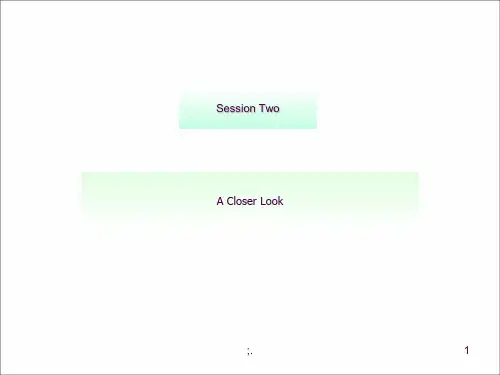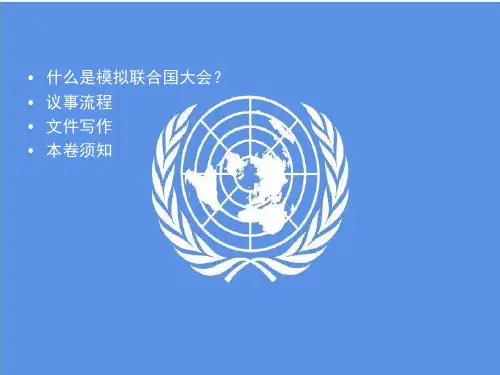- 1、下载文档前请自行甄别文档内容的完整性,平台不提供额外的编辑、内容补充、找答案等附加服务。
- 2、"仅部分预览"的文档,不可在线预览部分如存在完整性等问题,可反馈申请退款(可完整预览的文档不适用该条件!)。
- 3、如文档侵犯您的权益,请联系客服反馈,我们会尽快为您处理(人工客服工作时间:9:00-18:30)。
Total support required (sponsors + signatories) = 20% • One country can sponsor one draft resolution, sign many.
THE RESOLUTION-MAKING PROCESS
4. Formal debate on draft resolutions
THE RESOLUTION-MAKING PROCESS
3. Draft resolutions
After the working paper is introduced, and the bloc have already found a way to solve the problems, working papers must be converted to draft resolutions. Draft resolutions are also a set of solutions, but have a very specific format. • • Have 2 types of clauses – perambulatory and operative Perambulatory clauses are introductory clauses. Basically give the why of the draft resolution, i.e. why it is being written, history of the agenda, past action. Format – Bulleted, end with comma Operative clauses are the actual solutions. Format – numbered, end with a semi-colon, last operative ends with full-stop Clauses can only begin with specific phrases, which must be underlined Two types of support for draft resolution
• communicates with full control and understanding of the conventions of English grammar and usage. Experiments with sophisticated language and varied structured sentences ;
Contents of the Position Paper
Position Papers are a maximum of one page ( single spaced, Times New Roman, size 12 ) for each topic within the committee.
What is the use of a Position Paper?
Position Papers expand upon the high quality of debate at MUNs. They allow the delegates to organise their ideas. It aids the delegates in creating their speeches and being clear with their country’s stand.
• establishes and maintains clear focus: evidence of distinctive voice and appropriate tone ; • depth and complexities of policies supported by rich, engaging and pertinent details: evidence of analysis, negotiations, reflection and insight ;
THE RESOLUTION-MAKING PROCESS
1. Forming blocs After the committee has explored the causes, effects and solutions of the problem, an unmoderated caucus should be raised. During this unmoderated caucus, delegates should seek out the blocs with which they would want to form the resolution.
An excellent position paper includes :
A brief introduction to the country and its history regarding the topic and/or the UN body ; The country’s background on the topic, including Political and / or foreign policy ;
• • • Similar foreign policy w.r.t. agenda Similar geographic location (AU, EU, SAARC) Part of the saWorking papers After forming blocs, delegates should try to form working papers. •Working papers are a collection of solutions for the agenda, in no specific format. •They must have the support of at least 20% of the committee to be considered. •One country can support as many working papers as it chooses.
Action taken by the government in relation to the topic ; Resolutions, conventions and declarations that the country supports ; Quotes taken from speeches made by heads of government ; Statistics regarding the issue.
• frequent reference to international treaties, international organisations and real world stakeholders.
RESOLUTIONS
WHAT IS A RESOLUTION?
• A resolution is basically, a document which contains all the solutions and suggestions that the committee has come up with to tackle the problem • Resolutions are the end result of a Model UN conference. After all the debate and discussion has been completed, the fruits of the labor are the resolutions.
6. Voting • • • • • • After discussion and amendments, draft resolution is put to vote. Alphabetical roll-call voting takes place. Three types of votes allowed – Yes, No, Abstain. Yes – Delegate agrees with the resolution completely. No – Delegate disagrees with resolution strongly Abstain – Delegate is unsure of his stance towards resolution, and abstains, i.e. neither ‘Yes’ nor ‘No’.
5. Amendments
•
• • •
Any delegate can propose to amend a draft resolution.
Two types of amendments – friendly and unfriendly Friendly amendments – supported by all sponsors. Passed automatically. Mostly minor errors or last-minute changes. Unfriendly amendments – not supported by one or more sponsor. Brought to committee for roll-call vote. Requires simple majority (50% + 1 vote).
文件写作:
立场文件Position Paper 工作文件Working Paper 决议草案Draft Resolution 修正案Amendment
The Art of Writing a Perfect Position Paper
What is a Position Paper?










